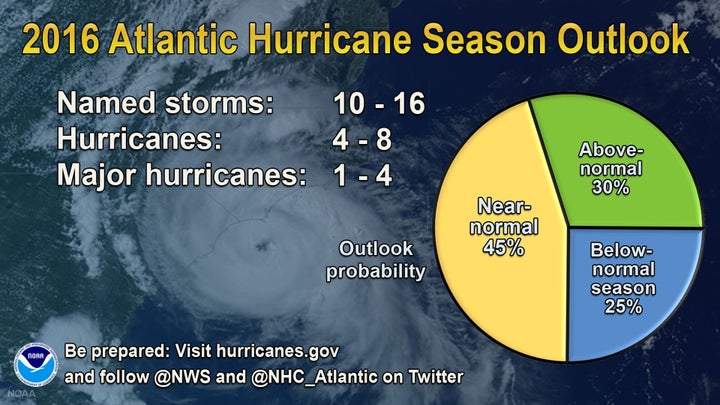May 27 (Reuters) - U.S. meteorologists on Friday predicted the number of storms in the upcoming hurricane season will increase from years of below-average levels, as a weather system brewed off the East Coast potentially disrupting Americans' Memorial Day weekend.
As Americans readied for the long weekend that marks the start of the U.S. summer, the U.S. National Oceanic and Atmospheric Administration (NOAA) said it saw a 70 percent likelihood of 10 to 16 named storms with winds of 39 miles per hour (63 kms per hour) or stronger.
Between 4 to 8 of them could become hurricanes with winds of 74 mph or stronger, including 1 to 4 major hurricanes with winds of 111 mph or more.

The estimate ends three years of below-average hurricane levels and is in line with other forecasters, who expect an increase due in part to the expected end of the El Nino weather phenomenon and the coming of La Nina.
NOAA included Hurricane Alex in its 2016 forecast. Alex was a pre-season storm that formed over the far eastern Atlantic in January.
In 2015 there were 11 named storms, including four hurricanes, of which two were major, according to federal data.
The Atlantic hurricane season runs from June 1 through November 30.
While a near-normal season is most likely with a 45 percent chance, there is also a 30 percent chance of an above-normal season and a 25 percent chance of a below-normal season, NOAA said.

NOAA included Hurricane Alex in its 2016 forecast. Alex was a pre-season storm that formed over the far eastern Atlantic in January.
In 2015 there were 11 named storms, including four hurricanes, of which two were major, according to federal data.
The Atlantic hurricane season runs from June 1 through November 30.
While a near-normal season is most likely with a 45 percent chance, there is also a 30 percent chance of an above-normal season and a 25 percent chance of a below-normal season, NOAA said.
"This is a more challenging hurricane season outlook than most because it's difficult to determine whether there will be reinforcing or competing climate influences on tropical storm development," said Gerry Bell, lead seasonal hurricane forecaster with NOAA's Climate Prediction Center, referring to changing water temperatures in the Atlantic and Pacific oceans.
The outlook comes as the U.S. hurricane center warned that a storm north of the Bahamas has a 90 percent chance of strengthening into a tropical depression or storm over the next day or two as it moves toward South Carolina.
The tropical storm, which would be named Bonnie, would bring drenching rain and gusty winds along the coast from Georgia to Virginia over the weekend, according to meteorologists at AccuWeather, potentially disrupting beach plans for Americans enjoying Memorial Day weekend.
The current El Nino, which started early in 2015 and typically warms central Pacific Ocean waters, was the strongest since 1997 and is expected to fade in early summer.
(Reporting by Scott DiSavino; Editing by Chizu Nomiyama)

